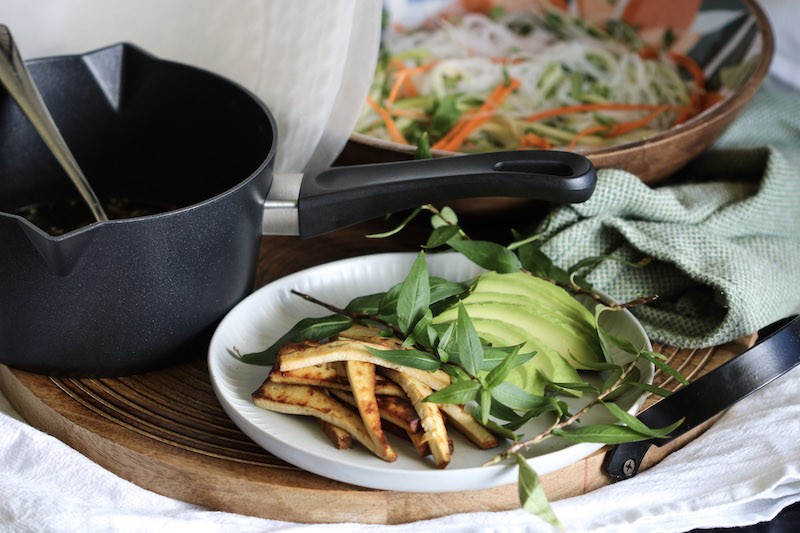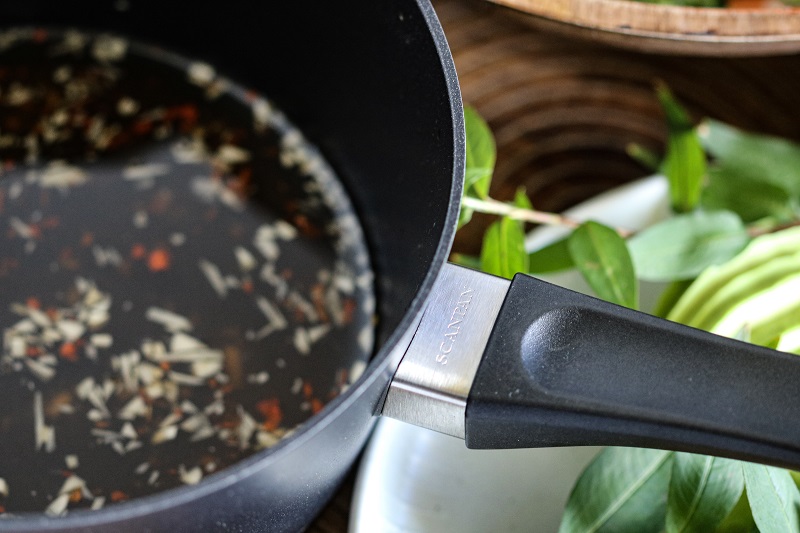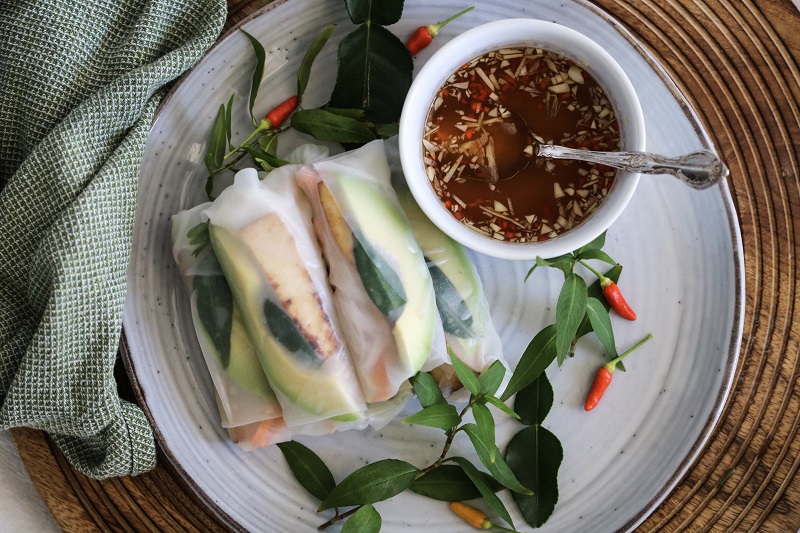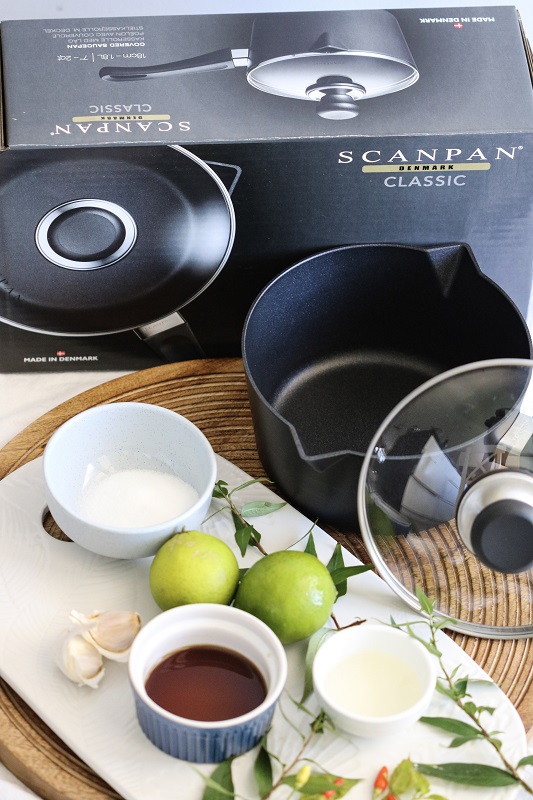What does nuoc cham taste like?
Traditional Vietnamese nuoc cham dressing is extremely diverse and can be added to many dishes. Nuoc cham is a staple in Vietnamese cooking made popular for the impact it has on the tastebuds – it certainly gets them tingling. Salty, sweet, hot and sour, nuoc cham embodies multiple flavours that will delight every sense and are absolutely umami. While nuoc cham dressing is most commonly found in Vietnamese restaurants, it's actually quite simple to make in a saucepan. I did mine in the Scanpan Classic one.
Nuoc cham can be used as a dressing for salads, as a dipping sauce for fresh rice paper rolls, to dress Vietnamese pancakes, or for fried dishes such as spring rolls. Pop the dressing in a lettuce cup with mince or seafood, and add some fresh Southeast Asian herbs to create the famous Thai street food salad – larb! My latest favourite way to utilise nuoc cham when feeling a little more upmarket is to dress fresh oysters or raw kingfish with it to make sashimi.

Is Nuoc Mam the same as Nuoc Cham?
Nuoc cham is a wider term used to describe a variety of Vietnamese dipping sauces. The base can range anywhere from fish sauce to rice vinegar, lime juice, soy sauce or chilli sauce. Nuoc cham dressings can have a variety of different flavour profiles, such as garlic, lemongrass, chilli, or shallots, to name a few. No matter what flavourings you add, it is called nuoc cham as a generalised term – its base is sweet, salty, hot, and sour.
On the other hand, nuoc mam is the name of a specific Vietnamese fish sauce dressing. In its simplest form, nuoc mam is fish sauce, sugar, water and rice vinegar or lime juice. Both the terms ‘nuoc cham’ and ‘nuoc mam’ can be used interchangeably depending on what you are describing.

For this recipe, I paired my nuoc cham dressing with rice paper rolls I made from scratch. Rice paper rolls are simple to make once you get the hang of it. They are also filling, healthy and extremely cost-effective. Additionally, rice paper rolls can be made with a variety of fillings. I like to start with a primary protein. Below are some of my favourites:
- Sous vide turmeric chicken
- Shredded leftover chicken
- Avocado+
- Lemongrass beef
- Barbequed beef
- Marinated tofu
- Cooked prawns
Next, boil your vermicelli noodles and strain them dry. Use kitchen scissors to slightly break up the noodles for easy rolling later. Add your favourite salads and herbs to the noodles in a bowl. Make sure the herb leaves are fresh and pulled from their stems, and salad ingredients are finely grated or julienned. Next, soak your rice paper sheets, add your fillings and roll according to the packet instructions. Don’t worry – you will get better the more you make! Some scrumptious filling options are:
- Bean sprouts
- Carrot
- Cucumber
- Mint
- Coriander
- Vietnamese mint
- Gem lettuce
Rice paper rolls are gluten-free and dairy-free. In general, Vietnamese cooking is known to be quite healthy and fresh with the use of therapeutically beneficial herbs and fragrant fruits and vegetables such as garlic, lemongrass, ginger, Vietnamese mint, limes and chilli.
Occasionally, I do crave some crunch. You can also make deep-fried rice paper rolls by blitzing proteins and herbs in a food processor and rolling them together with your glass noodles for frying. I was first taught to do this at a Vietnamese cooking class a few years back. I combined Mooloolaba king prawns, chicken mince, herbs, vermicelli and oyster mushrooms. Fry your rice paper rolls at 140°C for five minutes until crispy and dry on a paper towel. Heat the oil to 190°C and cook for a further 5 minutes. At this stage, your rice paper rolls will be incredibly crispy. Dip them into your nuoc cham dipping sauce, and your taste buds will certainly be satisfied by the flavour and texture.
As for cookware, I particularly love the Scanpan Classic covered saucepan 18cm for making my nuoc cham dressings. The circumference of the pan has been cleverly designed into the shape of a pouring jug. Two uses for one pan! Additionally, the even heat distribution, coupled with the lid, enables you to cook fast and accurately with the regulated temperature being easily within your control. Sugar dissolves easily in this saucepan when making your nuoc cham due to the non-stick surface. Simmering your sauce in a pot is also another option to consider, as it allows the flavour from the chilli and garlic to fully infuse for a broader flavour profile. Finally, heating the dressing ensures the sugar will fully disintegrate for a smoother mouth feel.

Tips for making nuoc cham dressing:
- Don’t overheat
- Prepare the day before
- Store in an airtight container or glass jar to keep for a couple of weeks – although fresh is best.
- Never add the lime juice whilst it is still cooking. Instead, squeeze to taste after cooking whilst it’s still warm. This will also give you the power to accurately control the flavour as well as avoid giving the dressing a bitter flavour.
- Always crush your garlic before dicing to allow the aromatics to circulate.
- Use bird’s eye chillies for a strong hit of spice. These can be substituted with long red chillies for a more modest flavour.
- The type of fish sauce you use can play a huge role in the final flavour result of your recipe - the quality can differ dramatically. Fish sauce is made from fermented fish and has been around for thousands of years. It’s a staple ingredient in Southeast Asian countries and is made using anchovies and/or shellfish combined with salt, fermented for many months. There are many types of fish sauce, with the Vietnamese style being lighter than others. Make sure you use a fish sauce with no additives, preservatives, or any added MSG. Also, check the anchovy/shellfish percentage. Cheaper versions of fish sauce are much more unhealthy and can be watered down.

Nuoc Mam Cham Dressing Recipe
Ingredients
- 1 garlic clove
- 2-3 birds’ eye chillis
- 3 tbsp fish sauce
- 3 tbsp rice vinegar
- 3 tbsp caster sugar
- Juice of ½ a lime
Method
1. Finely dice garlic and chilli.
2. Into a pot, add ½ cup of water, fish sauce, rice vinegar, caster sugar, garlic and chilli.
3. Gently simmer until sugar is dissolved.
4. Remove from the heat and squeeze in the lime juice.
Next Read: Thai Chicken and Pumpkin Light Curry Recipe


